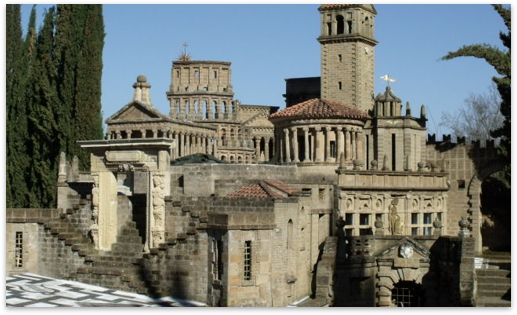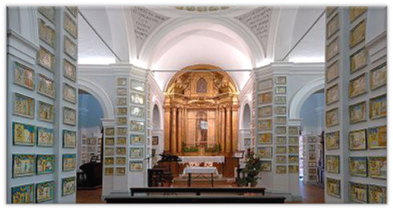Amazing to discover that there are also unusual places to visit in Umbria outside the most common and known destinations!
The Scarzuola of Tomaso Buzzi
Montegabbione, Frazione Montegiove (Terni) – ca. 60 km from us

It is the unfinished ideal city of the architect Tomaso Buzzi.
<<... to the scarzuola, when someone observes me that the new part, created by me, is not "Franciscan", I reply: naturally, because it represents the World in general and in particular my World - the one in which I had the destiny to live and work - of Art, Culture, Worldliness, Elegance, Pleasures (also of Vices, of Wealth, and of Powers, etc.) in which, however, I have made room for the oasis of meditation, study, work, music and silence, of grandeur and misery, of social life and hermit life, of contemplation in solitude, kingdom of fantasy, fairy tales, myths, echoes and reflections out of time and from space because everyone can find echoes of the past and notes of the future ... >>
Tomaso Buzzi
The smallest Theater of the World
Monte Castello di Vibio – ca. 40 km from us

The Teatro della Concordia was designed in full post-French revolution climate of 1789 and then named after that "harmony between peoples" that was being recreated in Europe at the beginning of the nineteenth century, when nine illustrious families of the country worked hard to to build a place of entertainment and meetings in Monte Castello (there was also a café-lounge).
With less than 200 square meters of emotional and artistic surface, the Teatro della Concordia became the demonstration that "civilization is not measured in cubic or square meters", as the nine families wrote.
How to blame them ... in this space of only 37 seats in the stalls which, added to the 62 seats located in the two tiers of boxes, make up a total of 99 seats, in addition to the stage, two dressing rooms, a meeting room, a Foyeur, services and an exhibition hall.
All the elements of the Italian-style Goldonian Theater are present in an admirably reduced proportion and stylistically with an enveloping and harmonious beauty: this characterization makes it the smallest theater in existence for functional completeness, architectural technique and size.
The Calamita Cosmica
Foligno – ca. 15 km from us

Lu Centru de lu Munnu / The Center of the World
Foligno – ca. 15 km from us
The monumental skeleton.
The work of Gino De Dominicis, created in absolute secrecy around 1988, is twenty-four meters long, almost four meters wide and faithfully reproduces a human skeleton with a long bird's beak nose, one of the recurring themes of his works.
A golden rod that starts from one of the phalanges is the "Cosmic Magnet" from which the work takes its name, a sort of magnet addressed to the universe.
The deep connection between earth and sky pervades the creative need for this majestic, dark and impassive sculpture.

Lu Centru de lu Munnu / The Center of the World
Foligno was at the center of the known world, of Mediterranean Sea, of Europe and of Italy...
and at the center of Foligno there was a famous cafè with billiards...
and the main billiard had 5 skittles..
and the skittle at the center was exactly The Center of the World !
Now, the point of the center of the world is in a modern shop, but still visible, just a small treasure hunt !
The Tempietto Templare di Perugia
Tempio di Sant’Angelo – ca. 40 km from us

Among circles, flowers of life, stars and patent crosses. But what are the traces of the Templar Order? Many scholars point to some of them:
- St. Michael the Archangel, to whom the church is dedicated, was considered the warrior-saint (like the Knights Templar)
- the circular shape of the temple (which later became that of many Templar buildings) which symbolizes the sky and the shape of the city of Jerusalem
- the presence of patent crosses and flowers of life both on some internal frescoes (you can check a Madonna painted with a red cross on the neck) and on the floor of the circular corridor
- a particular stone on the floor of the entrance, of a different color from the others, which seems to have been placed there almost by chance and on which a pentacle is engraved (a symbol associated with both the Templars and Freemasonry)
The Clitunno and the Temple of Unesco
Campello sul Clitunno – ca. 25 km from us

The Fonti del Clitunno are fed by underground springs that flow from cracks in the rock which, with their abundance in ancient times, formed a navigable river as far as Rome, along whose banks rose villas and baths.
Their evocative appearance, with the pond populated by aquatic nasturtiums, forget-me-nots of the marsh, swans and ducks, and with the myriad of colors of the willows and cypress poplars that are reflected in the clear body of water, inspired painters since ancient times, poets and writers, such as Pliny the Younger, Virgil, Corot, Byron and Giosuè Carducci, who consecrated them in his famous ode.
Considered sacred by the Romans who came here to consult the oracle of the god Clitunno and to perform religious rites, as evidenced by the presence further downstream of the Tempietto di Clitunno (later transformed into an early Christian church dedicated to S. Salvatore which preserves ancient frescoes) veins of the river waters were dispersed following the great earthquake of 440 a.C. Then adjusted by making them pass under the Marraggia, the Fonti assumed their current appearance in the second half of the nineteenth century.
Brufa and its sculptures
Brufa (Torgiano) – ca. 20 km from us

Brufa is a small village in the Municipality of Torgiano, on whose hills the vineyards of the prestigious wine production are located; it dominates the plain of the Tiber and the plain of Assisi up to Foligno, where "The Wine and Art Road" develops.
In this landscape the sculptures of various artists have been inserted.
Sanctuary of Madonna dei Bagni
Santuario Madonna del Bagno – ca. 25 km from us

The Sanctuary, founded in the 17th century, is located in the territory of the Parish of Casalina in the municipality of Deruta (in the province of Perugia). Currently the Diocesan CARITAS of Perugia - Città della Pieve, with the presence of its community, guarantees the opening to pilgrims.
Inside the Sanctuary, numerous ceramic tiles hang on the walls.
